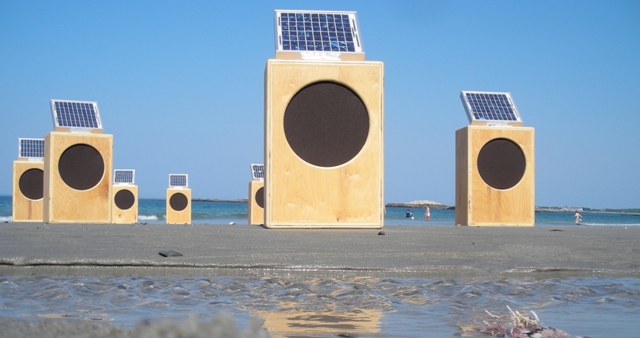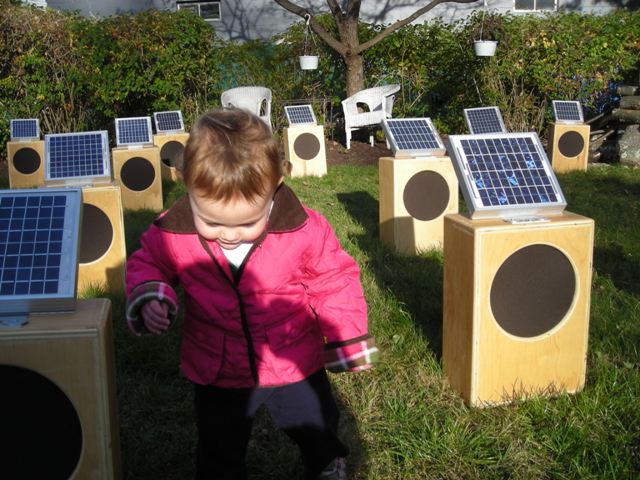A climate scientist and Google Science Communication Fellow who works at San Jose State University (SJSU), Eugene Cordero is passionate about what he calls “science that matters to society.” Cordero’s aim is to reduce annual carbon emissions by 1 million tons using the power of a climate-action superhero called the Green Ninja. The Green Ninja comes to life in a series of videos and social media tools designed to educate and inspire action to reduce our carbon footprint. Cordero is also co-author of the book Cool Cuisine: Taking the Bite out of Global Warming.
Category Archives: green art
Simon Beck’s Snow Art
Desert Manufacturing
[vimeo]http://vimeo.com/25401444[/vimeo]
Solar-sintering aims to raise questions about the future of manufacturing and triggers dreams of the full utilisation of the production potential of the world’s most efficient energy resource – the sun. Whilst not providing definitive answers, this experiment aims to provide a point of departure for fresh thinking. :Read on:
Martin Azua : Bios Urn
The Bios Urn project reintroduces the human being to the natural circle of life. It is the profaine ritual of regeneration and the return to nature. Bios is a mortuary urn made from biodegradable materials: coconut shell, compacted peat and cellulose. Inside it contains the seed of a tree. Once the urn is planted, the seed germinates and begins to grow. The seed can be changed for a different type of seed or plant more adequate to the chosen planting place, if need be. (Source)



DJ CAVEM : Green Hip-Hop
Check out the behind scenes video, by Denver, Colorado based artist, DJ CAVEM and his related music video:
[youtube]http://www.youtube.com/watch?v=DfdnuSWyQTI[/youtube]
[youtube]http://www.youtube.com/watch?v=OWBURAIMxoQ[/youtube]
Apart from youth outreach and his music, he teaches “Blue & Yellow Logic & Environmental Sustainability”:
The goal of Blue & Yellow Logic is to teach urban communities how to support themselves and the environment with this sustainability project. No back yard plots here. The gardens cover city blocks and provide enough food to feed several families throughout the year. Here Cavem supervises a soil delivery to agarden managed by the Eastside Grower’s collective. The project is gaining local and national attention. Recently, Blue & Yellow Logic has made arrangements to develop gardens at the home of Colorado Senator’s Michael Johnston and The Seanse-Elyri  Aquaphonic Grown House Project  in order to provide free organic food to the community.
Solar Powered Art – Craig Colorusso
A solar-powered art exhibit? It wouldn’t be the first time we’ve covered something of that sort on the vaunted pages of mnp, but it could be the coolest.
Creating the effect of an enchanted forest of singing trees, Craig Colorusso’s “Sun Boxes” installation can be walked through in a leisurely manner, or run through at full speed in a last ditch and extremely risky move to avoid the approaching enemy.
Sun Boxes is a solar powered sound installation. It’s comprised of twenty speakers operating independently, each powered by the sun via solar panels. Inside each Sun Box is a PC board that has a recorded guitar note loaded and programmed to play continuously in a loop. These guitar notes collectively make a Bb chord. Because the loops are different in length, once the piece begins they continually overlap and the piece slowly evolves over time.
Basically, I imagine this to be one harmonious but constantly changing, amplifying, and diminishing barrage of sound that keeps on rocking (God forbid it’s cloudy out). Although not billed as such, I find this to be a potentially very interesting and mesmerizing marriage of sound and mathematics. Plus, this ninja is from Beantown!
Craig will be at the IMA from March 18-20, for what we hope are 3 beautiful days. We recommend you wander amongst the enchanted sound-forest, put don’t pick the flowers!
We are all reliant on the sun. It is refreshing to be reminded of this. Our lives have filledup with technology. But we still need the sun and so does Sun Boxes. Karlheinze Stockhausen once said “using Short-wave radios in pieces was like improvising with the world.” Similarly, Sun Boxes is collaborating with the planet and its relation to the sun.
Phantom Bike by Olli Erkkila

An unusual bike design, “Forkless – Cruiser†by Olli Erkkila.He built it for his graduation project at the Institute of Design in Lahti, Finland.
The Dream Reborn (My President Is Green)
[youtube]http://www.youtube.com/watch?v=I52vlPByrUc&feature=player_embedded[/youtube]
[youtube]http://www.youtube.com/watch?v=wem2MC63Ufs&feature=player_embedded[/youtube]
always good stuff from Green for All out of Oakland.
Everyday Life as Climate Protest
The front lines of Copenhagen from the artists of The Canary Project via GOOD climate culture/counter culture:

Three vignettes from Copenhagen show that personal responses to the conference might be the greatest cultural happenings around.
This is part two of a GOOD mini-series by the Canary Project‘s Ed Morris on the cultural happenings surrounding COP15.
I.
I am running through the crowd with the French artist Thierry Geoffroy. He is saying (in a deep French accent): “Zee, it is getting dark. They are closing in. They are going to kill us all. This is the plan. But then we keep going and we move around a corner and Geoffroy is saying. Ah, but you see, now it is more calm. We have come to a different part. All that has past.”
Such was my experience of the mass protest in Copenhagen this past Saturday. Estimates vary widely as to how many marched. Fox News says 25,000; the organizers say 100,000; and the police say 60,000. There were arrests of 968 (this number appears exact).
In the media centers and on the street, more intense interest has been paid to the possibility of violence than any particular detail of the negotiations. This is understandable. In addition to our seemingly innate tendency to be fascinated and compelled by images of violence, there is the fact that the expression of violence is the one real thing happening here.
“Violence, when not in the hands of the law, threatens [the state] not by the ends that [the violence] may pursue but by its mere existence outside the law,” writes Walter Benjamin. “By what function violence can with reason seem so threatening to law and be so feared by it, must be especially evident where its application, even in the present legal system, is still permissible.”
The example that Benjamin gives to illustrate this point in “A Critique of Violence” is the worker’s strike – the state allows it to happen, despite its violent nature, because the power of the massed workers is sufficiently dangerous. The strike, like the protest, is violent regardless of whether it employs overt violence as a particular technique because it opposes order and the interests that constitute the state. Of course, even protests and strikes can go too far in the eyes of the state and claim a level of violence that the state cannot abide without losing authority. Protest, in both its permitted and non-permitted forms (both of which, by Benjamin’s definition, are essentially violent) is the most available and most direct negotiating tool for the 6 billion people not inside the Bella Center.
II.
Four people from different parts of the world arrive at Lykkesholms Alle 7C. They are greeted by a Danish family: husband, wife, and three boys, the youngest a baby. Also in the home are three women from Peru – two dressed in traditional highland clothing, one in jeans?and a camera crew of two people. After some small talk and a little getting to know each other, people take seats around a coffee table, others on the floor, some on chairs and a sofa. The camera crew remains standing. The children come in and out. The older of the Peruvian women asks for a photo from each person. She places the photos (given in the form of IDs) on some yellow flowers in the middle of the table, then gives each person a yellow candle. Each person writes his or her name and also his or her wishes for the next year directly onto the candle. The woman then lights each candle, muttering various incantations. She sprinkles sugar over the flowers and the photos and the candles. And then we sit and wait for each flame to burn down the wax entirely. Where we were rushing before, we are not rushing now. It is just the 14 of us in the room and the early northern darkness that presses against the window becomes a hypnotic abyss.
III.
A dinner of about 25 people in a home near the center of town: home-cooked food, arrangements of dried flowers on the table, and several bottles of wine. Many at the dinner are involved in one form or another with a labor-intensive intervention project that is calculated to have an effect on the media coverage of COP15. The dinner is a break in the preparatory work for this intervention. Again there is a camera crew filming the event. At some point, people start giving speeches. This has been planned, which surprises me, because everything leading up to it has seemed so casual. The first speech is by a scientist, who gives a long hymn to Tycho Brahe and the scientific process (truth above ideology, and so forth). He is followed by an art student talking about the power of images, who in turn is followed by a business professor on the topic of learning not to be frightened by the facts of a new world, who is followed by an artist and activist on the need to avoid the grips of institutions. Then the planned speeches end and one woman stands up and proposes that the fundamental problem with comprehending climate change is our inability to come to terms with death. She then speaks about a friend, Brad Will, who was recently shot dead during a protest. She gathers herself and sings a song the she and Will used to sing together. ??My karma is to good for you to worry ’bout the crazies / I love everybody and there’s nothing that I own??
I almost didn’t stay for the dinner. I said that I needed to go get some work done, that I was writing a blog about cultural response to the conference. The host said, “This is culture.”
warm analog glow

cassette tape lamps via Inhabitat.




